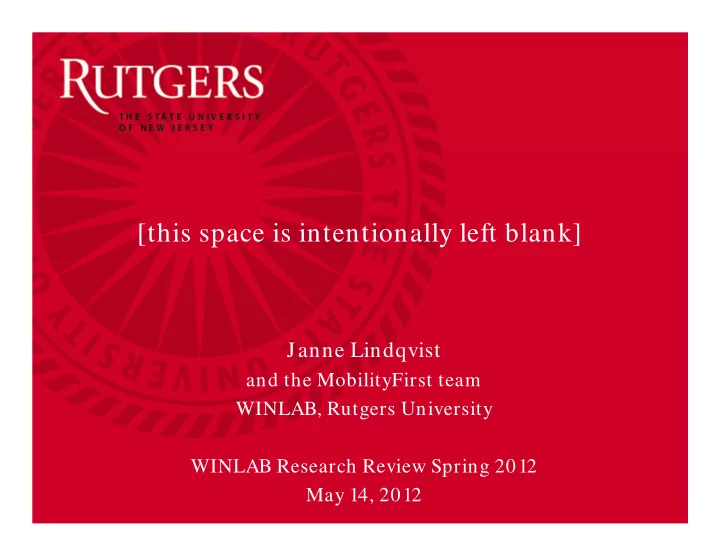

[this space is intentionally left blank] Janne Lindqvist and the MobilityFirst team WINLAB, Rutgers University WINLAB Research Review Spring 2012 May 14, 2012
Outline • Nudging developers to make better privacy decisions with clean-slate API design – (work-in-progress) • Security & privacy design and analysis for MobilityFirst
Human-Centric Research Agenda My agenda: Applying soft paternalistic nudges to hum an behavior with computer systems
Privacy-Preserving API design (w/ M. Gruteser) • Insight : today developers have options – take all, – or nothing • Evidence : some developers are trying to follow least privilege • 1. Question : Can we design a privacy- preserving clean-slate API?
• 1. Question : Can we design a privacy-preserving clean-slate API? – Yeah, probably • What w e should be asking : Can we nudge developers to make better user privacy decisions with novel API designs?
Evaluation: Lo-fi programming
Expected Results • Our preliminary studies show promise for the approach • Contributions: – Focus on developers – Novel way to evaluate APIs – New low-cost framework to evaluate the usability of APIs? • Poor API design can cost $$$$$$$$$$$$$
Outline • Nudging developers to make better privacy decisions with clean-slate API design – (work-in-progress) • Security & privacy design and analysis for MobilityFirst
Security and Privacy in MF (w/ W. Trappe, M. Gruteser) • In MobilityFirst, we are looking at security and privacy together because they really cannot be separated from each other – Introducing a security mechanism can have implications for user privacy – Introducing a user privacy mechanism can have implications to security • For example, without rigorous design, using public keys as identifiers in protocols can potentially identify users better than e.g. IP addresses today
Privacy & Security Stakeholders • Users • Operators • Network Providers • Third-Party Service Providers • Governments • Intelligence Agencies • Law Enforcement • … • Several approaches to privacy, in this presentation focus – on user privacy, and – on possible technical solutions
Attacks Against User Privacy • Who you are? – Have I seen you before? • Who do you talk to? – Did you talk to them before? • What are you talking about? • What is your location? – Have you been here before? • Note that these questions are connected – knowing places you go can tell who you are – e.g. home/ work pairs have been shown highly likely to be unique
Destination Server Attacker’s Location? Access Point User
Attacks Today: IP Packets • can observe – Source and Destination IP addresses in all attack locations – Resolve and observe names • You can change your source address, but research has shown that the set of your Destination IP addresses are highly likely to be unique WINLAB Amazon Some blog NSF
Attacks Today: IP Packets • can observe – Source and Destination IP addresses in all attack locations – Resolve or observe names of destination • might be interested in who is accessing particular server Sees what is the source address Some blog
Today: Solution Tor overlay
MobilityFirst: GUID and NA • can observe – Source and Destination GUID in all attack locations • You can change your source address, but research has shown that the set of your Destination IPs are highly likely to be unique, same principle applies to GUIDs GUID B GUID C GUID D GUID E GUID A
MobilityFirst: GUID, NA at destination • can observe – Source and Destination GUIDs in all attack locations – Resolve or observe names of destination • might be interested in who is accessing particular server Sees the source GUID, return packet “source” NA ??????????? Some blog
MobilityFirst Solution: Disposable Identifiers • Disposable identifiers have been proposed several times [e.g. Gruteser’03, Lindqvist’05, Lindqvist’08] • Today, even your disposable identifier is still often tied to your geographic location. – Thus, can discover where the packets are coming from • In MobilityFirst, disposable identifiers do not have geographic or semantic mapping – (Unless we add these)
Security & Privacy for MF packets • Off the record messaging on the network layer – Authentication – Encryption – Deniability – Perfect forward secrecy • We can build non-repudation and e-commerce applications on top of off-the-record network layer – The other way round does not work without additional complexity (e.g. overlays)
Summary • Nudging developers to make better decisions for user privacy • Security and privacy design and analysis for MobilityFirst – In MobilityFirst, we are looking at security and privacy together because they really cannot be separated from each other – Presented baseline privacy protections offered by MobilityFirst
janne@winlab.rutgers.edu Thank you
Backup Slides Ongoing work: • Analysis on impact of disposable identifiers in MF – Today, routing scales because you can request only as many disposable identifiers (IP address) as have been provisioned to the network – In MF, you could have arbitrary number of disposable identifiers • Reachability vs. Privacy • Privacy by Default, what is the right level of privacy the network should provide?
Recommend
More recommend